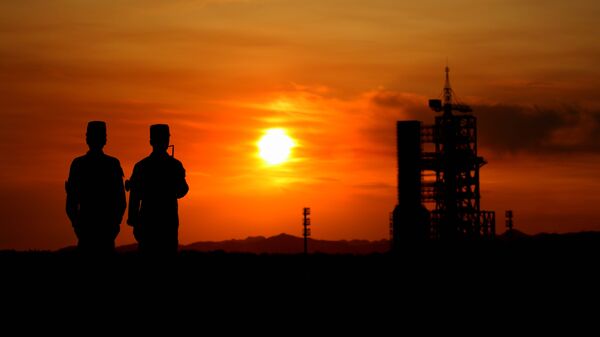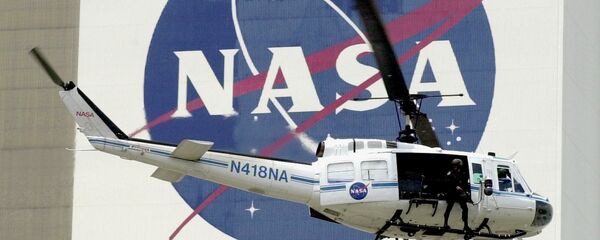MOSCOW, (Sputnik), Tommy Yang — China’s commitment to its space exploration programs is driven by the same sense of national pride that fueled the "space race" between the Soviet Union and the United States in the 1960s, experts told Sputnik.
Technological Prowess
China’s space programs topped the headlines this week after Chinese authorities unveiled more details of the nation’s Lunar exploration and manned spaceflight missions during the 2017 Global Space Exploration Conference in Beijing.
In addition, China is expected to launch four manned spaceflight missions over the next five years to build an operational space station, according to China's first astronaut Yang Liwei, who is now the deputy director of China's manned space program office. Yang added that two manned space missions will be conducted in 2020 and the first Chinese long-term operational space station will be completed by around 2022.
China has been making steady progress in its space exploration programs since the Chinese government approved the Shenzhou manned spaceflight program in 1992. Yang completed China’s first manned spaceflight in 2003, orbiting the Earth 14 times. And the Shenzhou 9 manned spacecraft, with the first female Chinese astronaut on board, docked with the Tiangong-1 prototype space station for the first time in 2012.
As traditional space exploration powerhouses including the United States and Russia scaled back their funding for spaceflight programs in the past several decades, China was set on continuing to invest in space exploration programs.
Experts suggested that political motives remain the main driver of Chinese space programs.
"Space exploration programs can demonstrate the technological capabilities for a country, showing it has the capability to do complex tasks," James Head, a professor of geological sciences at Brown University who worked on the Apollo project at NASA and provided training for the Apollo astronauts, said.
Head added that countries like India, Japan and the United Arab Emirates are developing their space programs for similar reasons.
"Today, China remains the only country in the world motivated by patriotic propaganda to finance its space achievements," said Egorov, noting that the early stages of space programs in the Soviet Union and the US also mostly served propaganda purposes.
Lei Fanpei, the chairman of China Aerospace Science and Technology Corporation, the main contractor for Chinese space programs, said China may be the only country to have a space station in service by 2024, when the International Space Station retires.
China even coined a new name for its spacewalkers. Similar to the words "astronauts" used by the United States and "cosmonauts" used by Russia, the crews of Chinese spaceflights are called "taikonauts", derived from the Chinese word "taikong" for space.
Costly Explorations
Following the launch of Sputnik 1 in 1957, the Soviet Union and the United States started a "space race" which lasted until the early 1970s. During that period, The Soviet Union beat the United States to send the first human, cosmonaut Yuri Gagarin, into space in 1961. The United States succeeded in the landing of first humans on the Moon with Apollo 11 in 1969.
But the space race also came with a hefty price tag. According to figures from a CIA research report, the Soviet Union spent an estimated $20 billion, about $145 billion in modern day dollar value, on its space programs, including hardware development costs. The Apollo Moon program cost US taxpayers a staggering $25.4 billion, which translates to around $184 billion in modern day dollar value.
NASA’s annual budget peaked in 1966 to $5.93 billion, which is valued at about $43.6 billion today, accounting for 4.41 percent of the US federal budget of that year. NASA’s approved budget for fiscal year 2017 stood at $19.65 billion, about 0.47% of total US federal budget.
According to Wu Ping, deputy director of the China Manned Space Agency, China spent about $5.74 billion on its Shenzhou manned spaceflight program from the time the program was approved in 1992 until 2012, when Chinese taikonauts completed the first manned docking mission with the Tiangong-1 prototype space station.
Professor Head acknowledged that, similar to the era when pioneering explorers such as Christopher Columbus needed to be funded by the Spanish Monarchy looking for gold, human exploration into space also faces a similar dilemma.
"Before you get to see a good business model, you can't convince people to spend money [on space projects]," Head said.
Head believes that China’s top-down decision making system may be an advantage in supporting the continuity of its space programs, adding that the US space programs have become "a hostage" of contrary decisions made by different presidents.
For example, former US President Barack Obama canceled plans to continue exploration of the Moon. Instead, he wanted NASA to send astronauts to Mars by the 2030s.
"We have set a clear goal vital to the next chapter of America's story in space: sending humans to Mars by the 2030s and returning them safely to Earth, with the ultimate ambition to one day remain there for an extended time," Obama wrote in the op-ed published in October 2016.
Lack of Cooperation
But China still faces an uphill battle when it comes to borrowing experiences from the United States or Russia from their previous successful space missions.
A two-sentence clause included in the US spending bill approved by the US Congress in 2011 prohibits the White House Office of Science and Technology Policy (OSTP) and NASA from coordinating any joint scientific activity with China. The clause, inserted by Representative Frank Wolf, a long-time critic of the Chinese government who chairs a House spending committee that oversees several science agencies, prevents OSTP or NASA from using federal funds "to develop, design, plan, promulgate, implement or execute a bilateral policy, program, order, or contract of any kind to participate, collaborate, or coordinate bilaterally in any way with China or any Chinese-owned company."
Yu Guobin, vice director of the Lunar and Space Exploration Engineering Center of China, was scheduled to speak at a symposium before the start of the Lunar and Planetary Science Conference in the United States on March 19 to discuss China’s plans to explore the Moon and Mars. But Yu informed the organizers that the US embassy in Beijing had denied his request for a visa to attend the conference.
"Even during the Cold War, there was not any harsh law like this preventing people working at NASA from communicating with their Russian counterparts," Head, who was an organizer for the symposium, complained.
He added that the law is hurting Washington more than China.
The International Space Station welcomed the first experiment independently designed by China, when SpaceX's unmanned Dragon cargo ship, carrying a 3.5 kilogram (2.2 pound) device from the Beijing Institute of Technology, arrived earlier this week.
In addition, as China and Russia seek to build closer bilateral ties, cooperation in space programs between the two nations is also expected to get a boost.
Russia and China discussed prospects for cooperation in the field of manned space flights, Sergey Krikalev, the executive director for manned space flight programs at Russia's Roscosmos State Space Corporation, said at the space conference in Beijing.
Russia's Lavochkin Research and Production Association is ready to work with China on designing Lunar exploration missions, including orbital and return ones, Sergei Lemeshevsky, the company's director general, told Sputnik on Thursday.









